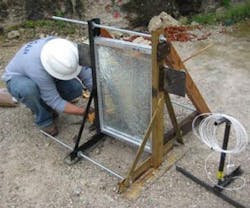New Blast-Resistant Glass for Structures and Buildings
A grant from the Department of Homeland Security’s Science and Technology Directorate has given a team of engineers from the University of Missouri and the University of Sydney in Australia the opportunity to create a new form of blast-resistant glass.
The blast-resistant glass is lighter, thinner, and colorless than other glass and is tough enough to withstand explosions, earthquakes, and hurricanes.
Installation of this new glass in buildings that are potential attack targets or in regions prone to severe weather could save lives. Prior to this research, blast-resistant glass has been so thick that it cannot fit into traditional window frames.
Unlike current blast-resistant designs which are made from pure polymer layers, this new glass is a plastic composite with an interlayer of polymer reinforced with glass fibers. Astonishingly, the new glass is only a quarter-inch thick.
The design utilizes long glass fibers in the form of a woven cloth soaked in liquid plastic and bonded with adhesive. Around half the thickness of a human hair, the glass fibers are a mere 15 to 1`5 micrometers in diameter.
"Designing an affordable, easy-to-install blast-resistant window could encourage widespread use in civilian structures, thereby protecting the lives of occupants against multiple threats and hazards," says John Fortune, manager of the project for the Infrastructure and Geophysical Division at S&T.
The new blast-resistant glass could be available in the next three to four years.
